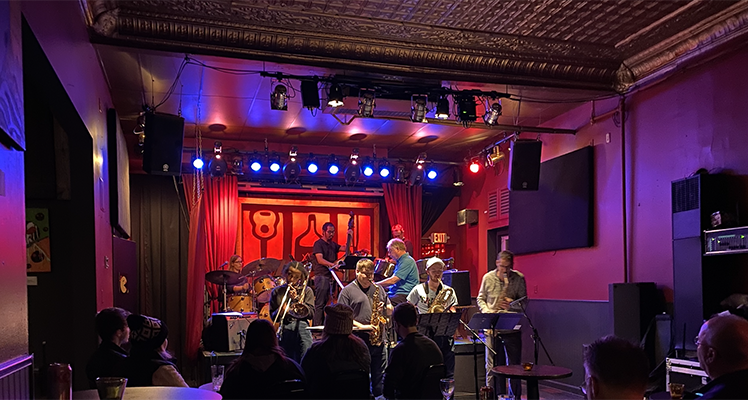
Jazz Program
The staple of any jazz program is its ensembles. The WSU Jazz Ensemble (MUS 244) is an elite group of outstanding musicians, selected by audition each fall semester. This 18-piece group performs both traditional and contemporary jazz in all styles from concert jazz to dance music.
WSU Jazz Combo (MUS 239) offers small group settings of four to eight players, performing Dixieland jazz through be-bop and modern fusion styles. Many of the combos feature original compositions and arrangements by the students. There is an audition required to participate in the combo program, which serves to place students in ensembles of equal experience.
The jazz ensemble and jazz combos are some of the most active groups on campus, performing several times each year. Many of the jazz concerts feature guest jazz artists from the U.S. and abroad, who perform with and clinic the groups, and provide additional individual instruction opportunities for students.
For further information about the WSU Jazz Program, please contact Dr. Aaron Lohmeyer at Aaron.Lohmeyer@winona.edu.
If you're interested in supporting the Jazz Program, learn about WSU's Friends of Jazz organization.
History of Jazz at WSU
We are proud of the rich jazz tradition that has been in place here at Winona State University since the 1940s.
1943-1946
Jazz performing groups at WSU date back to the early 1940s when all-girl bands, led by Gladys Anderson-DeLano and Dorothy Wildgrube, began playing for dances. The band, called Bunnie's Band, performed from 1943-1945.
With the end of World War II and the return of the servicemen from overseas, WSU had an influx of dance-band musicians. In 1946, Jim Cronen led the band.
1947-1972
Beginning in 1947, Fred Heyer became the director of bands and jazz studies at WSU, a position he held for the next 25 years. A master musician on woodwinds and piano, Heyer brought a number of players into the program and began to build a reputation as a leader and arranger. Mr. Heyer arranged dance tunes for his ensembles through the 1950s and 1960s - over 400 charts in all! Many are still housed in the WSU music archives and continue to be used for dance presentations today.
As early as 1948, Fred Heyer's Rhythm Masters graced the stage at WSU and the surrounding area as ballroom gigs were plentiful, and "dancing cheek to cheek" was the norm. The Rhythm Masters became the primary outlet for Heyer's arrangements. Some of these arrangements were published through the Hal Leonard Corporation, which was founded in Winona in 1947. There are also a number of record albums from the 1950s and 1960s that were produced under the name of Winona State College Rhythm Masters.
1973-1991
Fred Heyer's untimely death in 1972 left a void in the WSU jazz program that was ultimately filled by Lee Mendyk for 15 years (1977-1992). During the five years between Heyer and Mendyk, the band was ably fronted by Gene Anderson (1972-75), Dick Lindner (1975-76) and Richard Sovinec (1976-77).
Once Dr. Mendyk arrived in Winona, the jazz area grew to include two full bands and several combos by the 1980s. Under Mendyk, the bands played popular arrangements of Maynard Ferguson, Chuck Mangione, Buddy Rich, Butch Nordal, Thad Jones, Sammy Nestico and many others. Dr. Mendyk started a high school honor band festival, and the jazz ensemble was the featured group for the high school students who came to campus as guests to perform with their peers. One of the highlights of the jazz program during this time was the 1990 appearance of Clark Terry with the WSU Jazz Ensemble.
1992-Present
In 1992, the band welcomed a new leader as WSU welcomed their new clarinet and saxophone instructor, Dr. James Hoch. Hoch fronted the jazz ensemble from 1992 to 1996. During this time, the band made several touring appearances, including the Kansas Jazz Festival.
The most recent change of directors came in 1996, when percussionist Dr. Rich MacDonald joined the WSU faculty. MacDonald was at the helm until his recent retirement.
Currently, the jazz program features one big band and two combos. With the addition of the honor jazz festival, numerous guest artist appearances, and tours and performances around the region, the program continues to grow.

